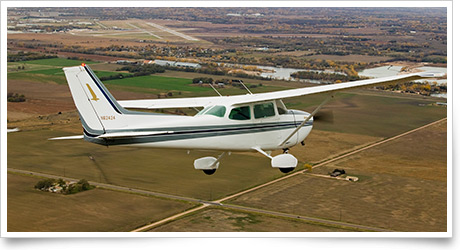Apr. 26, 2013, issue of 'AOPA ePilot: Flight Training Edition' weekly newsletter
|
||||||
|
Committed to a takeoff |
|
|||||
Training TipsCommitted to a takeoff
With room to spare on the runway, the student pilot discontinues the takeoff. Had there been any hesitation or uncertainty, it might have been too late for that.
Then what?
Unfortunately, you can read accounts of accidents that occurred when it would have been perfectly possible to continue the takeoff, fly the aircraft around the traffic pattern, and land normally. If a pilot has learned to correlate other sources of information confirming that the aircraft is performing as expected, a failed instrument is no big event.
Continuing the takeoff run, the pilot can sense the increasing speed and control responsiveness, despite the erratic instrument. With a gentle rotation to the takeoff attitude, the aircraft flies itself off. The pilot establishes the climb attitude—so familiar from many hours of pre-solo practice. With takeoff trim set, the pitch attitude should look and feel normal—another important cue.
Leveling off downwind, the pilot reduces power to the usual value, establishes the known pitch attitude, confirms level flight, and retrims. Setting known power and pitch (the sight picture) for the deceleration to flap-operating speed and for descending on base also will produce the expected results. Check the vertical speed indicator; it should indicate a normal descent rate. Tweak it with minor power changes if necessary, based on what you see outside.
Throughout the approach and landing, cues including power settings, the feel and responsiveness of the controls—even sounds—compensate for the missing airspeed information. Practice the exercise with your flight instructor, who will cover the airspeed indicator, perhaps letting you sneak a peek now and then to see how your airspeed estimates match the actual indications.
An important tip: Once you identify a failed airspeed indicator, eliminate it from your scan to avoid distraction, or cover it.
A blocked pitot tube on takeoff, followed by an unstable landing approach, led to the accident noted above. The National Transportation Safety Board commented that both the student pilot and instructor “reported that his flight instruction did not include operations simulating a loss of airspeed indication.”
Be sure to practice failed-airspeed scenarios, thus avoiding that unfortunate outcome! Flight Training NewsTechnique: The spin zoneSpins are the aviation equivalent of a schoolyard bully. They are intimidating and carry a fearsome reputation—but like most bullies, once confronted, spins turn out not to be so tough after all. With proper preparation, training, and equipment, spins can be understood, and even enjoyed, just like the many other maneuvers pilots learn. Read more >> Useful FBO appsWhen flying to an unfamiliar airport, it’s always helpful to see what services are available at the facility’s fixed-base operation. Apps allow users to access information about FBOs around the world. This week, AOPA looks at five FBO apps: AOG Service by Duncan Aviation, Multi Service Aero FBO Locator, Jet Aviation FBO, AIR Card FBO Locator, and Signature iFBO. Read more >> New David Clark headset built for comfortDavid Clark Co. is offering a smaller take on the aviation headset, a departure from the company’s long tradition of full-ear-cup designs. The DC Pro and DC Pro-X, an electronic noise-canceling version of the same basic design, were introduced at the Sun ’n Fun International Fly-In & Expo. Weighing in at 8 ounces (7.5 ounces for the DC Pro-X), the new headsets are built with a “supra-aural” design, riding on top of the ear rather than cupping it entirely. Read more >> Deadline nears for high school design competitionWith an April 30 deadline bearing down on them quickly, 24 high school teams across the country are scrambling to complete their virtual aircraft designs that will earn two of the teams a trip to Arlington, Wash., to build two real airplanes. The design and build competition pits the 24 teams against one another to build the best aircraft using the sophisticated Fly to Learn software package, which is provided free to the schools as part of a collaboration between the General Aviation Manufacturers Association and the nonprofit program Build A Plane. Read more >> Museum of Flight to hold B-17 ground schoolThe Museum of Flight will be offering a two-day ground school covering an iconic World War II bomber, the Boeing B-17, May 18 and 19 at its headquarters in Seattle. Sessions include familiarization with the design, construction, operation, and performance of the B-17, and briefings about its systems and how it is flown. The course also features personal tours led by the restoration team of the museum’s B-17F Boeing Bee. Nantucket Flying Association releases dates for annual aviation campThe Nantucket Flying Association will hold its 6th Annual Aviation Camp, “The Sky’s The Limit,” June 24 through 28. The camp targets youths aged 9 through 14 and covers aviation experiences including piloting an actual airplane. New aviation club helps students explore career optionsThe new Aviation Club at Florida’s Sebastian River High School has been created as a way to explore potential careers in the industry, reports Vero News. The club meets weekly to discuss aviation topics, including aircraft, physics, safety, and maintenance. Two of the students have gone on flights out of Sebastian Municipal Airport. Children of military wounded or killed can learn to flyFlorida-based foundation Teens-In-Flight was created to help the children of military personnel wounded or killed in action learn to fly—for free, reports General Aviation News. The foundation is the brainchild of Jack Howell, a retired Marine colonel with an interest in aviation. The organization is currently training 29 students—28 in Florida and one in Colorado. Just taking a cat nap?How do you cope with an overwhelming desire to close your eyes for just a few seconds? The Air Safety Institute Fighting Fatigue safety brief explains that a power nap can be a very effective way to regain alertness and the ability to make proper decisions. But obviously, no napping allowed while at the controls of your airplane! Get tips on how to avoid becoming fatigued and steps you can take to deal with it. Read more >> An ounce of preventionAs pilots, the ingredients we “cook with” in flying are lift, gravity, thrust, and drag. But there is so much more to the recipe of aerodynamics than those four forces. Having an understanding of the factors that keep an aircraft aloft can vastly improve your abilities, and your safety, as a pilot. Go beyond the textbook, and learn more by taking the Air Safety Institute’s Essential Aerodynamics: Stalls, Spins, and Safety online course. Take the course >> Training ResourcesIf good weather is permitting you to fly more, you might notice increased bird activity near your airport. Listen to a Real Pilot Story about an actual bird strike, brought to you by the Air Safety Institute.
Did you know that student pilots who join AOPA are three times more likely to complete their flight training? Membership includes unlimited access to aviation information by phone (800/USA-AOPA, weekdays from 8:30 a.m. to 8 p.m. Eastern time) or from Flight Training Online or AOPA Online. If you’re not already a member, join today and get the pilot’s edge. Login information is available online.
Advice for pilots amid ATC cuts
Career PilotHouston is JetBlue’s forty-ninth destination from LoganJetBlue Airways announced March 28 that it will add two daily flights between Boston’s Logan International Airport and Houston’s William P. Hobby Airport starting July 25. Houston will be the forty-ninth destination served by the carrier from Boston, as well as the seventy-fourth domestic city served nonstop by all carriers from Logan. JetBlue’s Houston flights will be the first regularly scheduled service between the airports, said Dennis Corrigan, JetBlue’s vice president of sales and revenue management. The airline said it’s moving closer to a goal of more than 150 daily departures from Boston, adding an average of five new destinations per year. Alaska begins nonstop San Diego-Boston serviceAlaska Airlines launched nonstop service between San Diego and Boston on March 29. Boston is the sixth new city the carrier has begun serving from San Diego in the past year. The others are Orlando, Fla.; Kauai, Hawaii; and Fresno, Monterey, and Santa Rosa, Calif. “Alaska Airlines is a key player in the transcontinental market,” said Ed Freni, director of aviation for the Massachusetts Port Authority, which owns and operates Boston’s Logan International Airport. Piedmont pilots ratify new contractPilots at Piedmont Airlines, a wholly owned subsidiary of US Airways, have voted to ratify a new five-year collective bargaining agreement that was reached on Feb. 1. The new contract was ratified by Piedmont Airlines’ 375 pilots, represented by the Air Line Pilots Association and based in Charlottesville, Va.; Harrisburg, Pa.; New Bern, N.C.; Roanoke, Va.; and Salisbury, Md. Details of the agreement will be made available by the Air Line Pilots Association.
For more aviation career news, see the Flight Training website. Plane SpotterMedium hauler: Bombardier CRJ
Training ProductsKing Schools introduce helicopter FIRCKing Schools has announced plans to release a new online helicopter flight instructor refresher clinic (FIRC) in the summer. The course, designed to run on an iPad or online, will include a paperless online renewal process. It will cost $99 without CFI renewal processing or $124.95 with processing. Revised airline cockpit manual releasedStephen Casner has released the second edition of The Pilot’s Guide to the Airline Cockpit. The book introduces readers to the fundamentals of today’s airline cockpit before entering training at an airline company. The print version is $24.95; the e-book PDF is $19.95.
Note: Products listed have not been evaluated by ePilot editors unless otherwise noted. AOPA assumes no responsibility for products or services listed or for claims or actions by manufacturers or vendors. Member BenefitsWhat is a CACI?A CACI is a new procedure that will allow your aviation medical examiner (AME) to issue your medical certificate in the office for some medical conditions that previously required a special issuance authorization. CACI stands for Conditions AMEs Can Issue. The FAA physicians in Oklahoma City and Washington, D.C., amended the certification policy (different and easier than having to change a regulation) for a group of low-risk medical conditions to eliminate the special issuance requirement. Read more >> Accident forgiveness, deductible waiver enhancement launchedAOPA Insurance has launched a program to help general aviation pilots save money in the event of an incident or accident. Partnering with the Air Safety Institute, AOPA Insurance now offers Accident Forgiveness and Deductible Waiver Enhancement on select insurance policies. Read more >> BlogsConfusing spin guidanceAOPA Foundation President Bruce Landsberg got a request from a reader in Canada who was confused by FAA wording on a placard. Read more >> The March ‘Since You Asked’ poll: Two at a time?In the March issue, AOPA asked digital Flight Training subscribers whether they have ever tried to train with two instructors at the same time. The question was sparked by a situation in Rod Machado’s column that involved a student pilot who was getting frustrated with the pace of his training. His instructor didn’t want to work weekends, which meant that between his own work schedule and weather, he wound up flying only a few times a month. Read more >> AOPA Career OpportunitiesEver dream of turning your passion for aviation into a career? We’re looking for a human resources assistant, software test and quality assurance analyst, online marketing and content specialist, AOPA Live editor/graphic artist, advertising marketing manager, mid-level gift specialist, network support engineer, aviation technical specialist, staff assistant/PAC coordinator, president of AOPA Insurance Services, major gifts officer, and director of outreach and events. To learn more about other AOPA career opportunities, visit AOPA Online. Community
AVIATION EVENTS & WEATHER
|
||||||||||||||||||||||||||||||||||||




 In the April 19
In the April 19 




